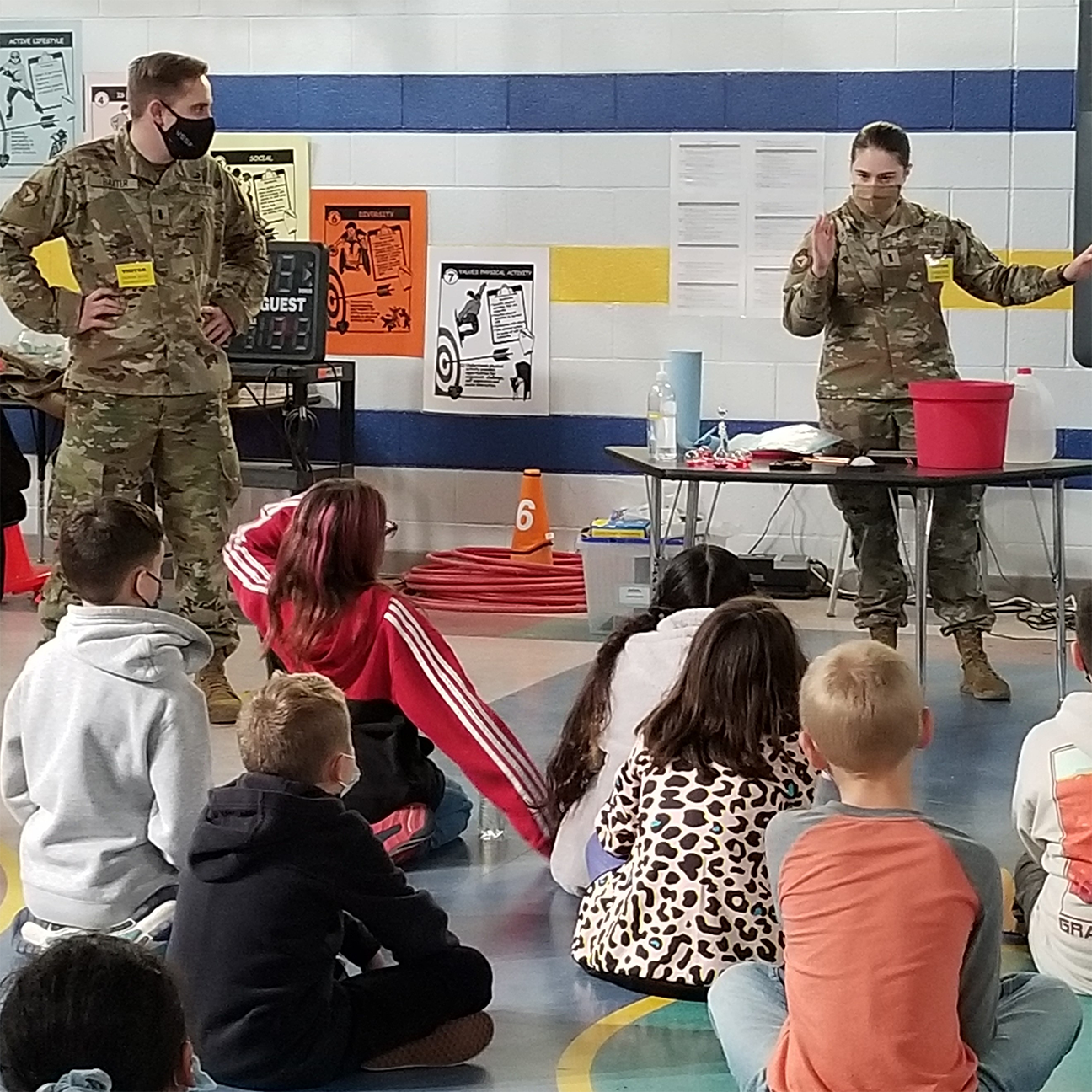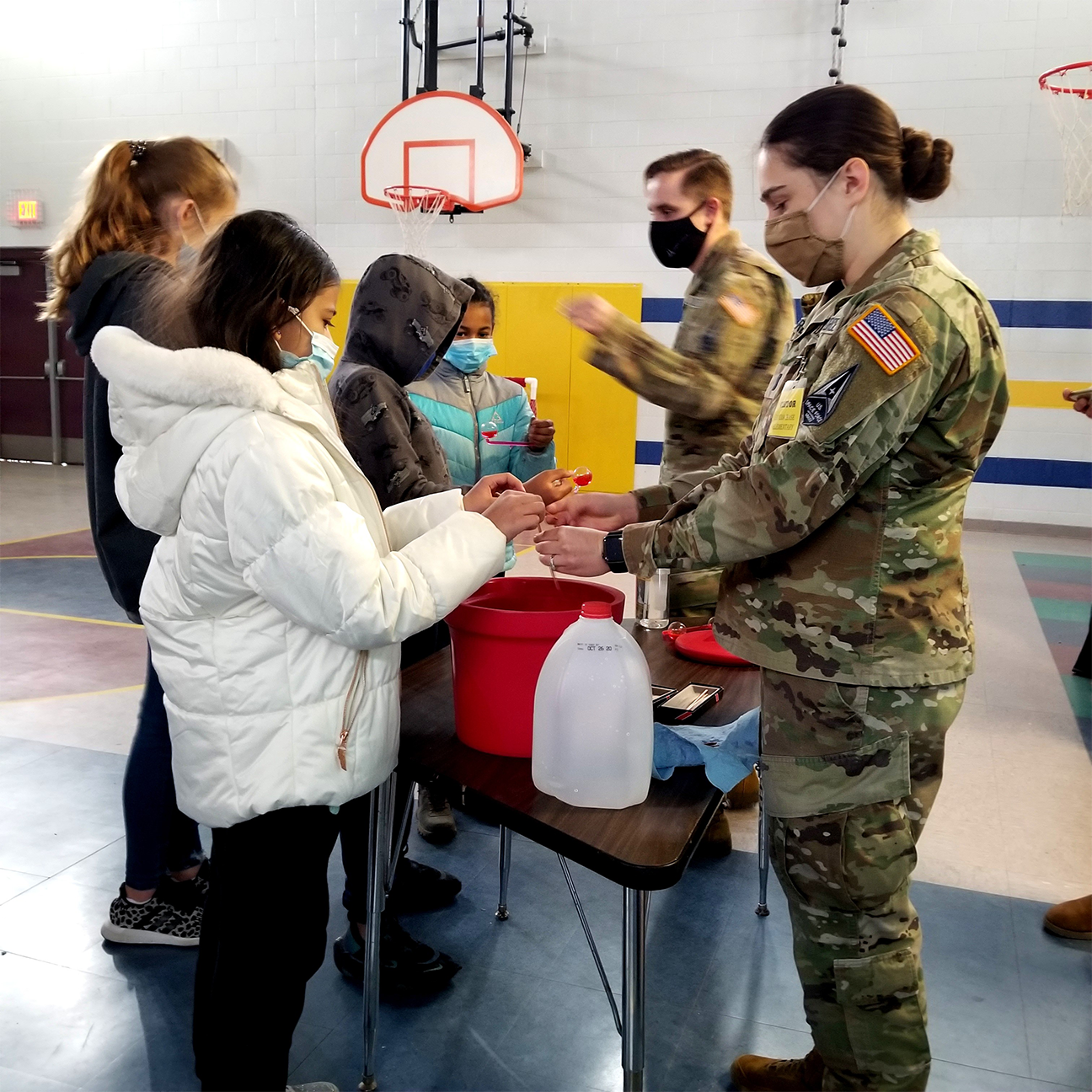AFRL takes STEMtoSpace to students in the southwest
KIRTLAND AIR FORCE BASE, N.M. (AFRL) – Members of Air Force Research Laboratory made stops in December at schools in the desert southwest, to put a face to the U.S. Space Force and encourage students to consider a career in the extra-terrestrial domain.
Lt. Mary Albrecht and Lt. Chance Baxter, both Space Force Guardians, visited the 4th grade class of Amberly Reyes, at Sandia Base Elementary School at Kirtland Air Force Base, New Mexico, and Col. Eric Felt virtually visited 5th grade students at Dorothy Hall Elementary School, in Yuma, Arizona.
As part of the U.S. Space Force’s STEMtoSpace initiative, Guardians around the country are visiting schools during the month of December, to coincide with the new service’s second birthday, which took place Dec. 19.
Lt. Albrecht, and her co-presenter, Lt. Baxter talked about their early interest in STEM, their educations, and what led them to their careers working in space.
“Presenting what I do at work to students, is one of the most fulfilling parts of my job,” said Albrecht, a deployable structures engineer at the AFRL Space Vehicles Directorate. “I was introduced to STEM activities at a young age, and I believe this was a large reason why I decided to pursue an engineering career.” “It thrills me to see young thinkers who are eager to solve problems, especially related to the future of space,” Albrecht said.
After the slide presentation, students lined up to take part in hands-on demonstrations that depicted the heating and cooling issues that have to be solved before a satellite can function properly on orbit. There was no shortage of questions from the class that included, “Why is it so cold in space?” and “How could you make oxygen so you could breathe in space?”
“The 4th graders were really engaged and limitlessly creative in their questions, and thoughts on space, said Baxter, assistant to Deputy Technology Executive for Space Science and Technology. “It is amazing to think that the future we are working to create, is for them.” It is always inspiring to share our work with the next generation of space scientists!”
Fourth grade teacher, Amberly Reyes was eager to sign her class up for the USSF program.
“STEM is great for students, especially right now because students were out of the classroom and social settings for over a year, and it really put a damper on their ability to problem solve and work with others cooperatively,” said Reyes. “STEM allows students to do both and having the opportunity for my class to experience and learn about how STEM reaches far beyond the classroom was an opportunity I didn’t want to miss.”
The Guardians pointed out that in order for rockets to go to space, many years of research and testing takes place on Earth, and that those kinds of jobs are also fun and rewarding.
“Students had the idea that working in space meant being in space, and through the presentation they learned that a lot of the work is done here,” Reyes said. “The second thing that struck me was the timing of projects. It was very good for students to see and learn that ideas take years to get into space, it doesn’t just happen overnight.”
Taking time from his busy schedule, the Director of the AFRL Space Vehicles Directorate, Space Force Guardian Col. Eric Felt, prioritizes community engagement, and this effort is a special one for him.
“Hello students at Dorothy Hall Elementary School,” Felt said, as he and the kids from four 5th grade classes, waived to each other. “We already have something in common—your school mascot is ‘the innovators’, and I am also an innovator.”
Felt presented a short history of space, presented an overview of the U.S. Space Force, and performed a “magic trick” that demonstrated power beaming, one of the lab’s biggest efforts, to beam solar power from space to Earth.
“It’s almost always sunny in space, so what a great place to locate solar panels. If we can collect the sun’s rays, beam it to ground, and then use the electricity, we would be providing power in a way that is friendly to the environment,” he explained.
After several questions from the students, Felt wrapped up the video call by encouraging them to pay close attention to their studies, because of the many opportunities they might have to work in space.
“When I was your age, there weren’t as many chances to work in, or go to space,” he said. “Now is the most exciting time, because space exploration is booming, and by the time you are old enough to start your career, thousands of people every year, will be going to space!”
When asked about the highlights of the outreach to 5th grade students, Felt had this to say.
“I can’t think of anything more important than motivating kids, and setting them on a course for an exciting career in space. The benefits of these engagements flow both ways, since their enthusiasm is contagious and left me with a smile for the rest of the day.”

The Air Force Research Laboratory’s Lt. Mary Albrecht, a deployable structures engineer (right) and Lt. Chance Baxter, assistant to the Deputy Technology Executive for Space Science and Technology, explain the problems that must be solved before a satellite can be launched into space, to 4th graders at Sandia Base Elementary School. (Courtesy photo)

The Air Force Research Laboratory’s Lt. Mary Albrecht, a deployable structures engineer (right) and Lt. Chance Baxter, assistant to the Deputy Technology Executive for Space Science and Technology, provide hands-on demonstration of thermal concepts that affect space exploration, to 4th graders at Sandia Base Elementary School. (Courtesy photo)

Col. Eric Felt, director of the Air Force Research Laboratory’s Space Vehicles Directorate, demonstrates the concept of collecting solar energy on orbit, and then beaming to Earth for usable electricity, to 5th graders at Dorothy Hall Elementary School, in Yuma, Arizona, in his virtual STEMtoSpace presentation. (Courtesy photo)
